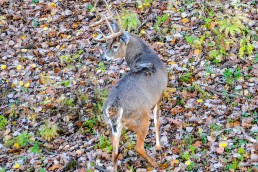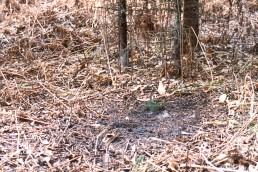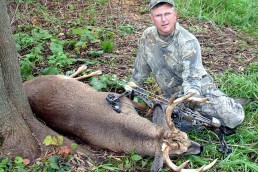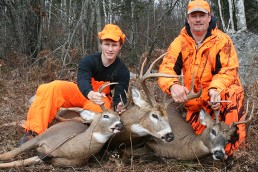Two Keys to October Big Buck Success
SHARE THIS POST
Take a hike along any logging road in whitetail country in mid-to-late October and you are sure to stumble onto both rubs and scrapes made by whitetail bucks. Rubs and scrapes are the two keys to your success on any typical bowhunt at this time of year. Rubs and scrapes reveal the travel patterns of both individual bucks as well as an entire group of active, aggressive, pre-rut males.
Let’s first talk about rubs. The term rub was coined by bowhunters decades ago to indicate a bark-scarred tree that was worked over by a whitetail buck by rubbing its antlers against it. In fact, the entire outer bark area of a typical rub-tree, from 1 to 4 feet off the ground, is likely to be completely debarked. Rubs expose a yellowish-white woody flesh typically called the cambium. Bucks begin rubbing various trees in early September. Essentially as soon as they lose velvet and their antlers harden.
Hormone-driven tells
A rise in the hormone testosterone triggers increased rubbing on various trees throughout the fall. Rubbing is simply part of buck behavior. It is part of their aggressive nature at this time of year as well as part of the overall pre-rut routine. Quite often, an individual buck seeks out certain-sized trees as well as specific species (of trees). In fact, the astute hunter might even be able to determine the route of an individual buck, simply by its rubbing signature. For example, a smooth-antlered buck will generally produce a clean, polished rub on a tree. One with gnarly tines is sure to create a unique shredding and gouging impression.
Additionally, preferred travel routes are revealed by repeated rubbing on a series of trees on any given section of a woodlot. This is often called a rub line. Anytime you note a series of rubs on a number of trees, slow down and really look things over. You are now in an area that either a single buck or a group of bucks are spending some considerable time at. Try to locate an actual line of rubs connecting feeding areas to bedding areas. Then, along this rub-line route, keep a watchful eye for anything in the terrain that enables you to take advantage of deer travel in a hunting situation. In many cases, this means locating some kind of land feature or terrain contour that funnels deer towards a specific spot. This is where you want to set up to hunt.
Are you enjoying this post?
You can be among the first to get the latest info on where to go, what to use and how to use it!
Bigger rubs frequently mean bigger bucks
The size of the rub is also some indication of the size of the buck that made the actual rub, but not always. In other words, more often than not, small rubs made on saplings are made by smaller bucks. Large rubs on trees of four inches in diameter, or more, are usually made by larger, more mature bucks. However, I have witnessed both small, yearling bucks and great big mature ones visiting the same rubbed tree, but at different times. These are very special communication rubs—literal stop signs for nearly every buck passing through that given area. Obviously, these are great rubs to set up a stand nearby and hunt.
The second key buck sign of October is the scrape. Scrapes are essentially pawed-out patches of earth created by a whitetail buck. An active scrape usually has some deer prints in it, as well as some deer droppings nearby. Much misinformation has been passed along by various sources on what scrapes are, what sex of deer make them, and the role that scrapes actually perform in the fall mating ritual. No matter what you may have heard about scrapes in the past, my own observations suggest the following:
What scrapes are really saying
Scrapes are generally made by bucks to communicate with other bucks. They have nothing to do with does. Bucks make scrapes to advertise themselves as well as to keep tabs on all the other bucks in the area. It is important to note that scrapes may be visited and reworked by more than one buck. Scrapes are usually made and positioned in locations so that various bucks can monitor them as they travel through the area. As the level of the hormone testosterone increases in a buck’s system throughout the fall, he is likely to make more scrapes. He will also freshen his existing ones more often.
It is also important to note that every buck living in that immediate area, from the smallest yearling spiker to the largest-racked stag, may spend some time visiting some of the same scrapes. The most-dominant ones will likely urinate in the scrape, paw the earth more, and spend a lot of time working the overhead licking branch common to every good scrape. In fact, the licking branch above the scrape is quite possibly more important as a communicator than the ground scrape itself. Smaller, subordinate bucks may not paw the earth in the scrape or even think of urinating in it, since this is a sign of dominance. Yet, they are almost sure to work the overhead licking branch.
Bucks branching out
As a buck works a licking branch, he is trying to deposit his own signature scent from a gland near his eyes, commonly called the preorbital gland. At the same time, he is scent-checking the licking branch in order to determine if any other bucks have visited this scrape area recently. Finally, some scrapes are much bigger than others simply because they are visited more often and are hit by a number of bucks. They continue to get bigger and bigger throughout the fall season. As you can well imagine, these community scrapes are the best ones to hunt.
Rubs and scrapes are the two keys to your success during the month of October. Scout aggressively until you locate rubs and freshly pawed ground scrapes this October. Hang a stand as soon as you find these signs and start hunting pronto!
MWO
SHARE THIS POST
Did you enjoy this post?
You can be among the first to get the latest info on where to go, what to use and how to use it!
Joe Bucher
Joe Bucher is a Freshwater Fishing Hall of Fame Legendary Angler, book author, lure designer and host of Fishing with Joe Bucher TV series.



